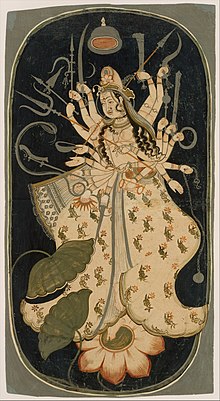| Mahadevi | |
|---|---|
| |
 | |
| Devanagari | महादेवी/आदिशक्ति/पराशक्ति |
| Sanskrit transliteration | Mahādevī / Ādiśakti / Parāśakti |
| Affiliation | |
| Abode | Manidvipa |
| Mantra | Ōm āim hrīm śrīm klīm[1] |
| Weapon | Devi Chakra, Pasha, Ankusha, Trishula (trident) |
| Symbol | Hreem, Om, Sri Yantra |
| Mount | Lion |
| Texts | Devi Suktam, Devi Mahatmya, Devi-Bhagavata Purana, Markandeya Purana, Brahmanda Purana, Lalitopakhyana, Kalika Purana, Lalita Sahasranama, Soundarya Lahari, Shiva Purana, Shakta Upanishads such as the Devi Upanishad[2] |
| Festivals | Navaratri, Durga Puja, Vasanta Panchami, Lakshmi Puja, Kali Puja, Durga Ashtami, Lalita Jayanti, Adi-Puram |
Mahadevi (Sanskrit: महादेवी, IAST: Mahādevī), also referred to as the Devi, Adi Parashakti and Mahamaya,[3] is the supreme goddess in Hinduism.[4][5] According to the goddess-centric sect Shaktism, all Hindu gods and goddesses are considered to be manifestations of this great goddess, who is considered as the Para Brahman or the ultimate reality.[6]
Shaktas often worship her as Durga, also believing her to have many other forms.[7][8] Mahadevi is mentioned as the Mulaprakriti (Primordial Goddess) in Shakta texts, having five primary forms—Parvati, Lakshmi, Sarasvati, Gayatri and Radha—collectively referred to as Panchaprakriti. All other goddesses are regarded as her Amshavatara or partial incarnations. Author Helen T. Boursier says: "In Hindu philosophy, both Lakshmi (primary goddess in Vaishnavism) and Parvati (primary goddess of Shaivism) are identified as manifestations of this great goddess—Mahadevi—and the Shakti or divine power".[9]
| Part of a series on |
| Hinduism |
|---|
 |
- ^ Narayanananda 1960, p. 50.
- ^ Jones, Constance; Ryan, James (2014). Encyclopedia of Hinduism. Infobase Publishing. p. 399. ISBN 978-0816054589.
- ^ Mani, Vettam (1975). Puranic encyclopaedia : a comprehensive dictionary with special reference to the epic and Puranic literature. Robarts - University of Toronto. Delhi : Motilal Banarsidass. pp. 217–219. ISBN 978-0-8426-0822-0.
- ^ Vanamali (21 July 2008). "3. Mahadevi". Shakti: Realm of the Divine Mother. Simon and Schuster. ISBN 978-1-59477-785-1.
- ^ Dalal, Roshen (6 January 2019). The 108 Upanishads: An Introduction. Penguin Random House India Private Limited. ISBN 978-93-5305-377-2.
- ^ Hay, Jeff (6 March 2009). World Religions. Greenhaven Publishing LLC. p. 284. ISBN 978-0-7377-4627-3.
- ^ Pintchman, Tracy (21 June 2001). Seeking Mahadevi: Constructing the Identities of the Hindu Great Goddess. SUNY Press. p. 9. ISBN 978-0-7914-5007-9.
- ^ Bonnefoy 1993, p. 95.
- ^ Boursier 2021, p. 30.